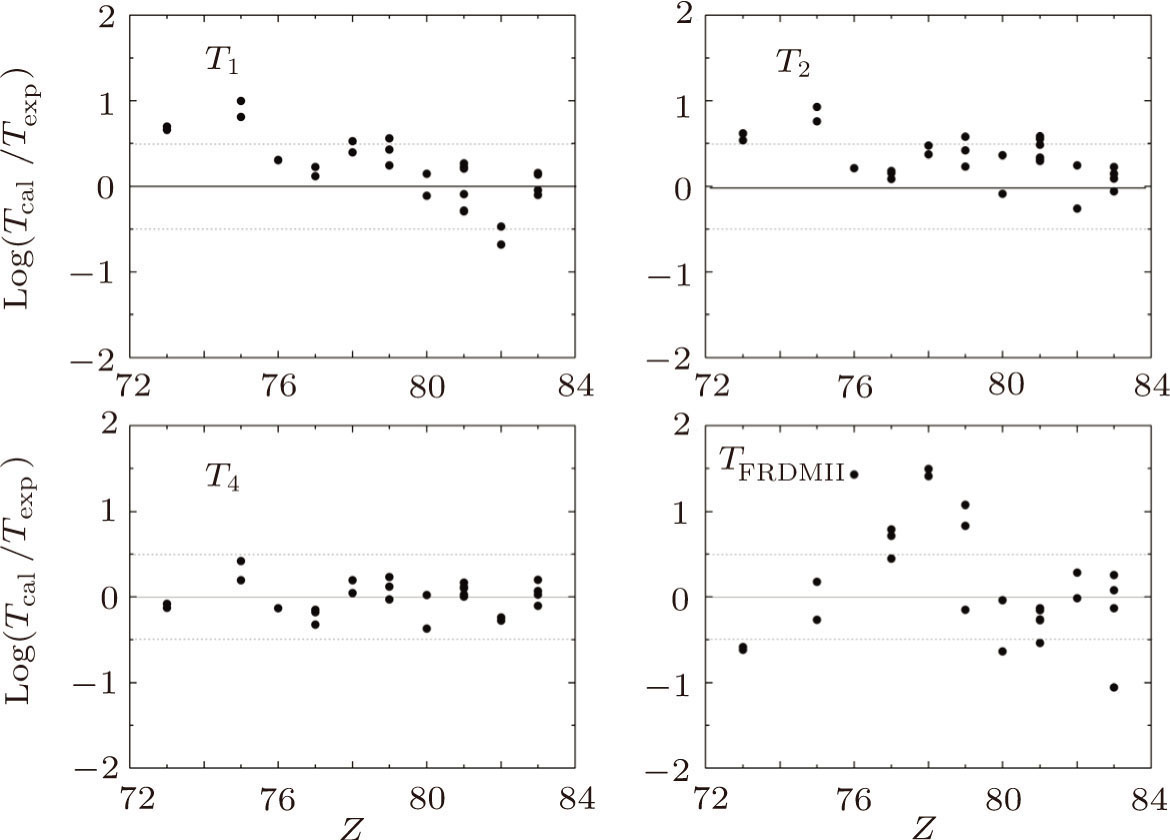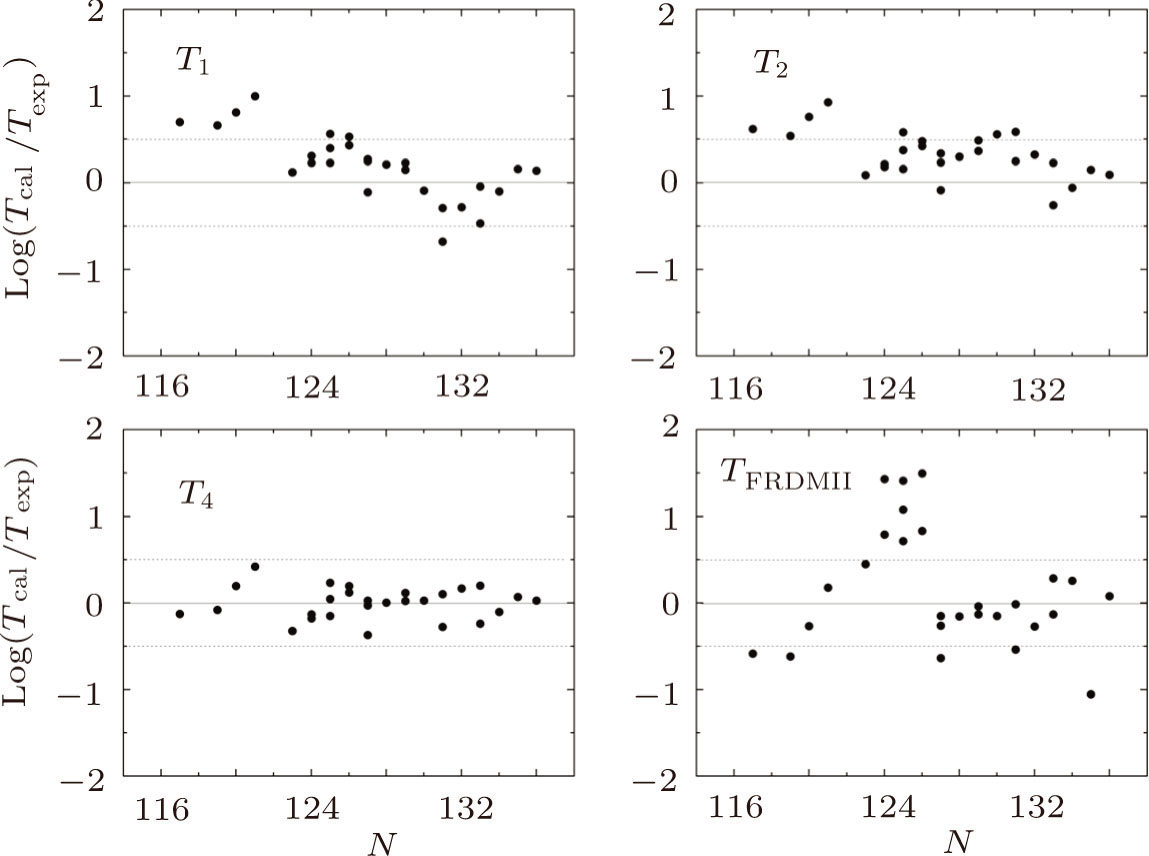

† Corresponding author. E-mail:
Supported by the National Natural Science Foundation of China under Grant Nos. 11565010, U1731238, 11365006, 11761161001; Guizhou Province Science and Technology Innovation Talent Team under Grant No. 2015(4015); The Innovation Team Foundation of the Education Department of Guizhou Province under Grant No. 2014-35; the Training Program for Excellent Young Talents in Science and Technology of Guizhou Province under Grant No. 2011-29; the Scientific Research Program for the Returned Overseas Chinese Scholars of Guizhou Province, under Grant No. 2013-03; the Science and Technology Development Fund (FDCT) of Macau under Grant Nos. 020/2014/A1, 008/2017/AFJ, 119/2017/A3; and the Key Program of the Student Scientific Research Foundation for Natural Science of Guizhou Normal University
We have systematically analyzed the experimental 



The β-decay half life is one of the most important weak interaction reaction rates. It is of great significance for not only nuclear structure research, but also for astrophysics.[1–5] From astrophysical point of view, the β-decay half-lives are much important for nuclei synthesis (thus star elements abundance) and evolution of stars. It is the competition between β-decay rates and neutron capture rates that determines by which ways (rapid neutron capture process (r process) or the slow neutron capture process (s process)) the heavier nuclei in universe are produced. For r process, in which the β-decay rates is smaller than the neutron capture rates, seed nuclei can capture a neutron and hence make heavier nuclei before they decay by β-transition. It is believed that half of the neutron-rich atomic nuclei heavier than iron are made by the r process. Nucleus lighter than Fe is produced though thermonuclear reactions. Now, it is generally accepted that r process occurs in these environment, high temperature and high neutron density, although the actual site of r-process is hard to be determined.[6–8] Under these conditions, neutron captures are dominant in comparison with β-decays, and the r-process path moves along a chain of extreme neutron-rich nuclei. Along these paths, the so called waiting point nuclei with magic number N = 50, 82, and 126 are of great interest because the large neutron separation energies of these nuclei make r-process matter flow slow down when it reaches these neutron magic nuclei. It waits for some β-decays to occur before further neutron captures are possible. The mass flow are carried to heavier nuclei and consequently the matter is gathered, which leads to the so called peaks in abundance distribution of r-process. Thus, the β-decay half-lives of the waiting point nuclei are very important because it is the key to understand the third r-process peak of heavy nuclei with mass numbers A∼200. From the point of view of nuclear science, β-decay half-lives of waiting point nuclei are also of great importance, because the decay rates are mainly determined by the Q values and the transition matrix elements, which are strongly affected by the nuclear structures and thus are very important quantity for nuclear structure study, especially the shell structure far from stability.
Despite their importance for astrophysics and nuclear physics, a few experimental data of half-lives are obtained only for waiting point nuclei with N = 50 and 82.[3,9–11] For N = 126, experimental data are very absent. Thus, for astrophysical r-process simulations, the needed half-lives only rely on theoretical estimates. The situation of half-lives for nuclear structure study is also the same. Therefore, theoretical calculations of half-lives are very important. Since Fermi[12] first proposed β-decays theory in the 1930s, many scientists have done a lot of theoretical research on the calculation of β-decay half-lives. Because the Q-values are much low, these studies have considered mainly on allowed transitions. The Quasiparticle Random Phase Approximation (QRPA) either on top of semi-empirical global models[13–16] or the Hartree-Fock-Bogoliubov method or the shell model is applied to these calculations, which reproduces well the experimental half-lives of waiting point nuclei in r-process.[17–19] The calculations can give a reasonable account of the few experimental data, however, some of these microscopic calculations are time-consuming and model dependent. Therefore, besides the microscopic calculations, there exist other phenomenological methods. Sargent[20] proposed a law that the β-decay half-lives is proportional to the fifth power of β-decay energies 
Very recently, the forbidden transitions are included in the QRPA and the shell model calculations. The first forbidden transitions are considered and half-lives are calculated for waiting point nuclei around neutron number N = 50, 82, and 126.[24,25] It was pointed out that the forbidden transitions become very important and must be considered for waiting point nuclei around N = 126. As we know, the available experimental data around N = 126 are very poor. In addition, microscopic calculations including forbidden transitions are very time-consuming. Therefore, it is of great importance to give another theoretical calculations of the waiting point nuclei around N = 126. In this paper, we will re-exam the formulae in the literature[22] by taking into account the forbidden transitions and the shell effects with the aim to give better description of β-decay half-lives for waiting point nuclei around N = 126, which are very useful for nuclear structures and the third peak elements production in stars.
The paper is organized in the following way. In Sec. 


Zhang et al.[21,22] systematically analyzed the experiment β-decay half-lives of nuclei and discovered an exponential relationship between 







Zhang et al.[22] have tested the accuracy and reliability of the two formulae. For the chosen center of N = 131 in the Gaussian function in Eq. (


By a least-squares fit to the available experimental data of 27 nuclei with Z = 73–83, N = 117–136, we obtain a new set of parameters: c1=−0.002 87, c2 = 0.041 88, c3 = 0.785 26, c4=−37.1312 and c5=0.635 56, respectively. Here, the Gaussian center N=131.5 in Eq. (

In Table 
| Table 1
|
In Figs. 
 | Fig. 1. The logarithms of the ratios between calculated values from T1 (Eq. ( |
Based on the above formulae, we calculated the half-lives of 76 nuclei with Z = 73–82 and N = 121–139 for both nuclear and astrophysical purposes. The results together with theoretical calculations from FRDM models with and without forbidden transitions are listed in Table
| Table 2.
Predicted |
In summary, by considering the contributions of forbidden transitions, the 


| [1] | |
| [2] | |
| [3] | |
| [4] | |
| [5] | |
| [6] | |
| [7] | |
| [8] | |
| [9] | |
| [10] | |
| [11] | |
| [12] | |
| [13] | |
| [14] | |
| [15] | |
| [16] | |
| [17] | |
| [18] | |
| [19] | |
| [20] | |
| [21] | |
| [22] | |
| [23] | |
| [24] | |
| [25] | |
| [26] |












































